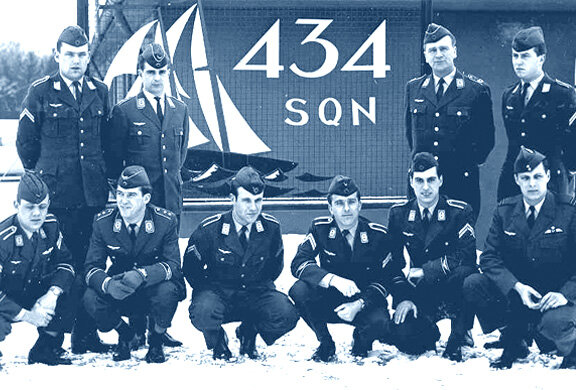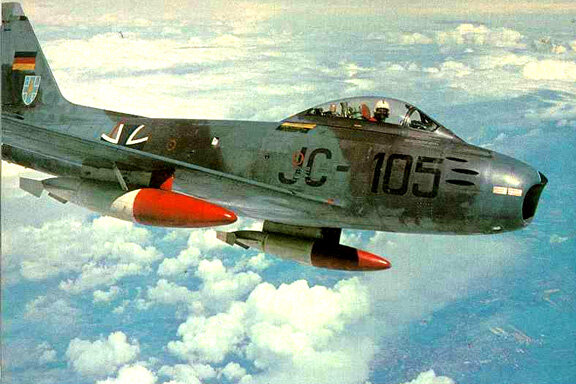ACHTUNG SABREJETZ!
When the post-war Luftwaffe of the German Federal Republic was formed in September of 1956, plans called for the formation of several air defence day-fighter wings. The choice of a suitable aircraft was one of the lesser problems facing the new Luftwaffe. The best available type was clearly the Canadian-built Canadair Sabre 6, so 225 brand new examples of these great aircraft were ordered in December, 1956. These would be complemented by 75 Sabre 5s drawn from the Canadian Air Division as the RCAF upgraded its twelve Air Division squadrons to the Sabre 6.
The Mark 5s were flown to Renfrew, Scotland, where they were overhauled by Scottish Aviation for the Luftwaffe and then were ferried by Canadian pilots to Waffenschule 10 (WS 10), the Sabre operational conversion unit at Oldenburg in Northern Germany. Under the terms of an intergovernmental agreement, Canada also undertook to train 360 pilots to jet fighter standards on the Sabre for the fledgling New Luftwaffe.
It must be noted that twelve RCAF squadrons, based at the four Canadian fighter wings in Europe, had been flying the Sabre for several years and had become widely renowned as the best air defense operation on existence at that time.
My first introduction to the new German Air Force was in late 1957, when four of us from 422 Squadron were tasked to ferry four of the refurbished Sabre 5s from Renfrew to Oldenburg for WS 10. It was quite a surprise to arrive at Renfrew in the early morning to see the four Mark 5s, newly painted with the iron cross insignia on the side ready for us to launch on the ferry flights. Enroute we stopped for refueling and lunch at the famous RAF air base at Manston in southeast England. What a surprise we turned out to be for the Wing Commander. After taxiing past the memorial Spitfire and Hurricane on our way to the parking ramp, we were greeted on shut down by the Wing Commander, who looked quite startled when who should jump out of these four German cockpits but four operationally-clad Canadian Sabre pilots who promptly gave very proper Canadian salutes. Later in the day, we continued on to deliver the four aircraft to WS 10.
Members of the Canadian Advisory Group at WS 10 Oldenburg, March 1961, Paul Hayes, the author is fifth ROm the left. Photo via Paul Hayes
RCAF 422 (Fighter) Squadron formation at 4 (Fighter) Wing, Baden, The author, Paul Hayes, is flying No.2 . Photo via Paul Hayes
Refurbished ex-RCAF Sabre 5 ready for the author to ferry to WS 10, late in 1957. Photo by Paul Hayes
Related Stories
Click on image
My next introduction to the German Air Force did not come until March 1961. By that time I had been over three years at 4 (Fighter) Wing Baden with 422 Squadron and was wondering when my next posting would show up. We had just arrived back from 422 Squadron’s latest semi-annual live weapons shoot in Sardinia when a message came in saying that I was posted to join the Canadian Advisory Group at WS 10 in Oldenburg.
I cleared quickly from 422 Squadron at 4 Wing and headed north for Oldenburg. On arrival, I was informed by the Canadian CO, Squadron Leader Walt Moore, that I was not to be joining the Canadian instructional cadre at WS 10, but rather would be assigned as a Tactical Advisor to JG 73 (Jagdgeschwader or Fighter Wing 73), the final Sabre 6 German day fighter air defense wing to be formed. On this assignment, I was joined by Flight Lieutenant Alex Leslie, another Canadian Sabre pilot who had served with 421 Squadron at 2 (Fighter) Wing at Grostenquin, France.
Alex and I immediately set to work. JG 73, which was comprised of two Staffels or Squadrons, had been formed in 1959, but by 1961 when we arrived, progress had been gradual. It was still receiving brand new aircraft and pilots newly trained at WS 10. The Wing remained at “Oldy” until October 1961 and then we moved to its new permanent air base at Pferdsfeld/Sobernheim, located in the Eiffel Mountains, not far from the three major USAF fighter bases at Bitburg, Hahn and Spangdahlem, and near the beautiful German city of Bad Kreuznach.
Paul Hayes (bottom right) poses in the snow with pilots of JG 73 during operational flying training at RCAF 434 (Fighter) Squadron, Zweibrucken. Photo via Paul Hayes
Our main task was to bring the Wing and the German pilots up to NATO operational status by training them as element and section leads, and in jet fighter tactics and in air to air weapon operations. At the new base, facilities were not fully completed and many aspects were quite limited, but thanks to the cooperation that we were able to arrange with the Canadian Air Division, we managed to set up periodic visits to the four Canadian air bases and to arrange intercept practice missions against Canadian Sabres under the control of the Canadian heavy radar “Yellowjack” located at Metz, France.
The structure of 73 Wing was quite interesting. Under the command of Oberst (Colonel) Fritz Schroter, ably assisted by Oberstleutnant (Lieutenant Colonel) “Jolle” Josten, the Wing Operations Officer, both very experienced World War II fighter pilots, the Wing consisted of two Staffels. About 30 percent of the pilots were of officer rank, while the rest were of several non-commissioned ranks, the equivalent of our corporals, sergeants, and warrant officers. It was the non-commissioned pilots that did the majority of the flying, as many of the officers were encumbered with managing the numerous details of the administrative side of the operation.
JG 73 Sabre 6 with special identification drop tanks. Photo via Paul Hayes
A number of the pilots had Second World War experience, mainly on fighter operations, so this was a benefit in adding to the understanding among the pilots of achieving a high level of proficiency and the overall approach to training for potential combat operations.
On a typical mission, once the German pilots had reached a competent level as wingmen, Alex and I would take up the role as wingmen ourselves so we could work at training the pilots as two-ship element and four-ship section leads so as to bring the Wing up to the standard required for it to take up its NATO alert responsibility. This was accomplished in mid-1962 and the first four aircraft were immediately placed on NATO alert at the end of the runway. A major change in the weaponry on the German Sabres came in 1962 with the addition of two sidewinder heat-seeking missiles to augment the standard six 50 caliber machine guns. Although this added to some extent to the offensive fire power, the extra weight and drag did detract from the speed and turning performance of this marvellous aircraft.
JG 73 Sabre 6s in the pastoral countryside at Pfersfeld. Photo via Paul Hayes
One additional issue was that many of the young pilots and ground crew were serving on mandatory national military service. It meant that they were only with us for about two years. This had some adverse effect on the level of experience, on the time available to complete effective training and on the resources available for a high level of maintenance operations. On the plus side for the maintenance operation, the Wing was very ably assisted by two Canadian civilian technical representatives from Canadair and Orenda Engines – Jack Forbes and Terry Mottershead.
Overall, it was a great two or so years. Alex and I were able to train many of the pilots to be capable fighter leaders and had seen 73 Wing achieve its NATO qualification. We left JG 73 in 1963 fully gratified by their accomplishments and having the opportunity to work with a group of aviation people sincerely committed to achieving the operational goals set out for them.
JG 73 Sabre 6s on NATO patrol. Photo via Paul Hayes
Subsequently, in 1964, the Wing was converted to the fighter bomber role and was renamed to JABO (Fighter Bomber Wing) 42 and was re-equipped with the Fiat G91 aircraft. In 1971 the aircraft was changed again to the RF4E Phantom and the Wing re-designated JABO 35.
After the re-unification of Germany in 1991, the Wing took over the operation of the Russian MIG 29s, and JG 73 was re-formed at the former East German air base at Rostock/Laage with both RF4Es and MIG 29s. In 1997 the Wing was officially designated the “Steinhoff” Wing in recognition of one of Germany’s great World War II fighter aces.
In 2000, the Wing became the first German Air Force unit to fly the new Eurofighter “Typhoon” aircraft. Its first Squadron provided an air defense capability with the Typhoon, while the second squadron, after retirement of the RF4Es in 2004, became the German Air Force operational training unit for the Typhoon. In 2004, the remaining MIG 29s were sold to Poland.
I have continued to follow the activities and development of 73 Wing, and really have to say how proud I am to have had the opportunity to fly with a great group of German aviators and to add to my Sabre flying experiences. Both made up a marvellous ride.
Paul Hayes is a retired Canadian Air Force Brigadier General with over 7,500 hours in his logbook. He is also Honorary Colonel with 400 Tactical Helicopter Squadron at CFB Borden, Ontario and remains very active with the Canadian Owners and Pilots Association. He continues as a consultant with the Hawk One project, sharing his considerable knowledge of the Sabre with our team of pilots and maintainers.













